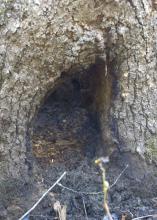Information Possibly Outdated
The information presented on this page was originally released on November 3, 2017. It may not be outdated, but please search our site for more current information. If you plan to quote or reference this information in a publication, please check with the Extension specialist or author before proceeding.
Bats seek shelters for winter months
STARKVILLE, Miss. -- Cooler fall weather leads bats and other wildlife in search of shelter for the winter months.
Bats are an integral part of Mississippi’s ecosystem balance, consuming large quantities of unwanted insects and supporting forest communities. However, they can become nuisances when groups of bats, called colonies, take up residence in homes or other buildings.
Although bats don’t cause structural damage or chew wires like rodents do, they can be noisy and cause health concerns when large amounts of unpleasant smelling droppings accumulate. Bats that get trapped inside a wall or attic can likely die there, causing a strong odor as they decompose.
Increased human development and habitat loss are the main causes for bats’ need to roost in human dwellings. In very rural areas where natural bat habitat still exists, bats reside in trees or caves. In more urbanized areas, bats have adapted to roost in barns, houses, bridges, attics, roof voids, porch eaves and other human structures.
Occasionally, a misguided bat will enter a house, school building or other structure. The bat may be as frightened as the building occupants. People can easily guide the bat outside by turning on interior lights and restricting its access to one area by closing the doors to other rooms. Use an upright broom to guide a bat to an open exterior door or window. An expert animal control specialist can be called if the bat will not vacate the area.
The most effective method for deterring bats from roosting in buildings is through exclusion. Proper exclusion includes installation of a one-way mesh or wire valve that allow bats to leave the roost but not return.
Devices such as repellents, traps, chemicals and mothballs are not only ineffective, but also inhumane and could cause harm to the structure, environment, pets and children who come in contact with the bats. Federal laws also prohibit lethal removal of bats while females are raising their young from May through September, so legalities should also be considered before bat eviction.
There are many examples of easy and inexpensive exclusion devices that can be made at home with just a few items. Several wildlife companies also sell ready-made tube-like bat exclusion cones and doors. The do-it-yourself designs, as well as the prefabricated versions of the devices, can all be found on-line through the Bat Conservation and Management website found at http://www.batmanagement.com/havebats/nuisance.html.
Once the bats are evicted, it will be necessary to seal the openings with silicone caulk or foam insulation to prevent them from returning.
Installing a bat box in a tree at the property boundary, away from homes or buildings, can provide resident bats an alternative place to roost. It may take a full year for the bats to locate the new roosting site, but eventually a colony of 100-200 bats can inhabit a two-sided box. Many choices for bat box designs, both already constructed and DIY, can be found online. A bat box will deter bats from living in human structures while providing all of the bug-eating benefits of these impressive creatures.
 Editor’s Note: Extension Outdoors is a column authored by several different experts in the Mississippi State University Extension Service.
Editor’s Note: Extension Outdoors is a column authored by several different experts in the Mississippi State University Extension Service.

Editor’s Note: Extension Outdoors is a column authored by several different experts in the Mississippi State University Extension Service.








